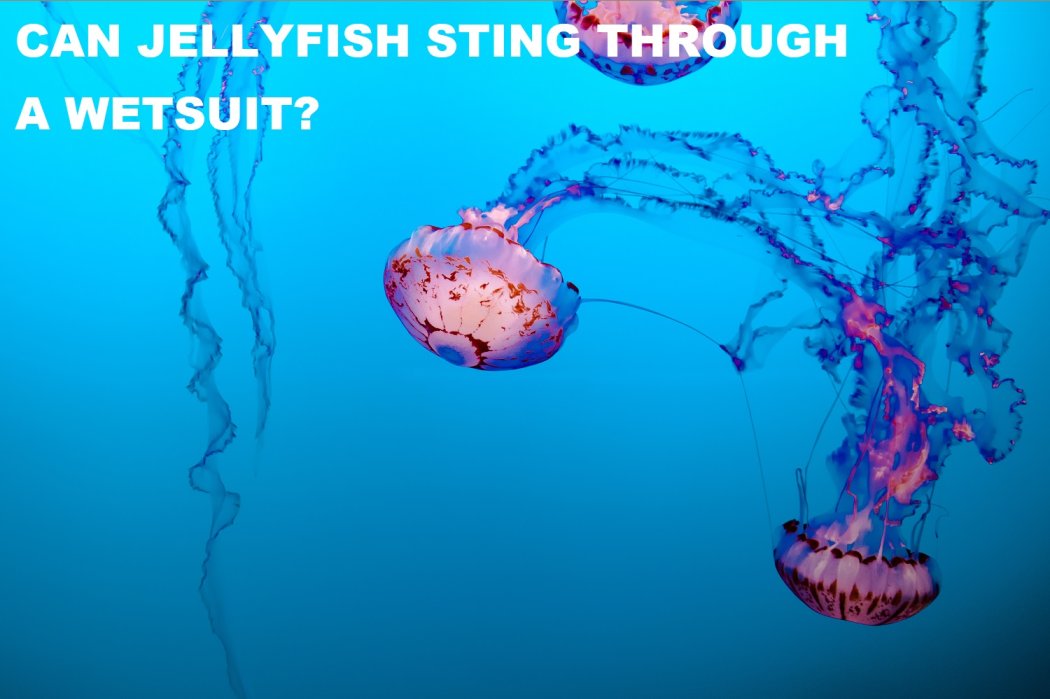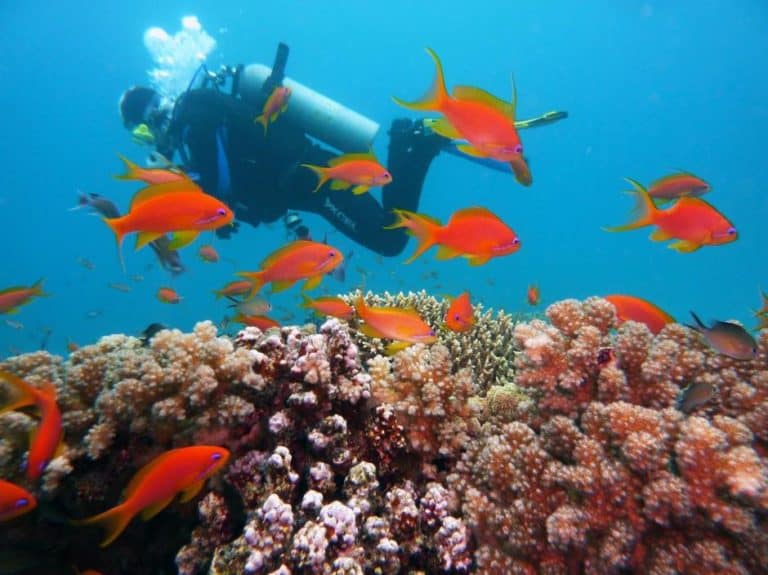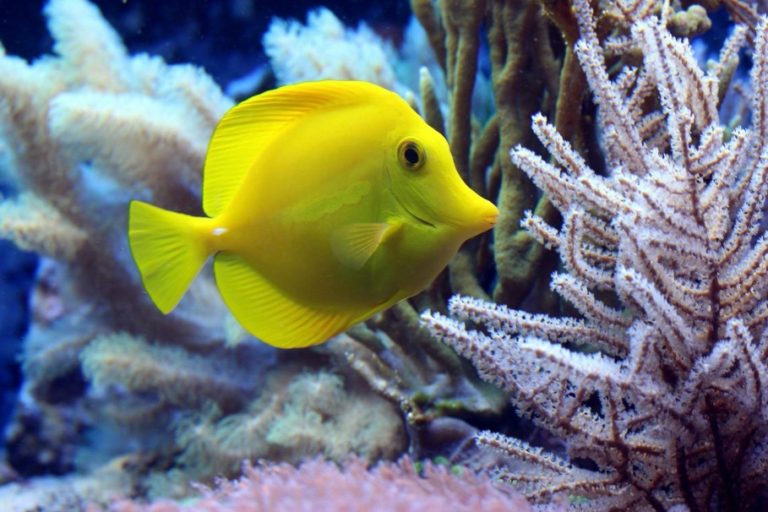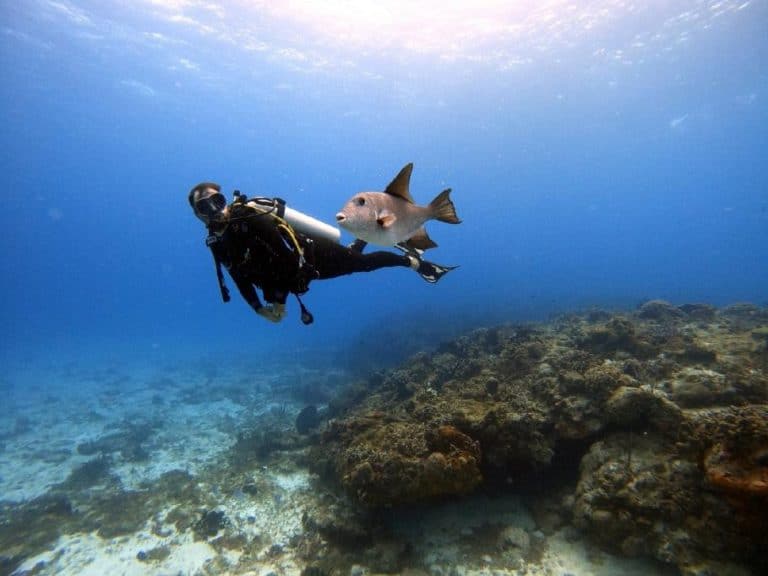Can Jellyfish Sting Through A Wetsuit?
Going out for a walk on the beach, going swimming, surfing, or scuba diving, jellyfish can sting you when you least expected it. If you have never experienced a jellyfish stinging you a lucky as the pain is very excruciating. You can feel the pain travel through each nerve in your body. As a beginner in scuba diving, you may wonder can jellyfish sting through a wetsuit.
No jellyfish cannot sting through a wetsuit. Most scuba diving wetsuits have a 3 – 5 mm thickness which is sufficient in protecting divers from jellyfish stinging. However, it’s important to remember that jellyfish can still sting you in exposed areas such as hands, face, and legs.
Scuba divers wearing shorties have more body parts exposed increasing the surface area available for stinging.
If you are planning on scuba diving in areas known to have jellyfish, avoid wearing shorties. It’s advisable to wear diving booties and gloves with your full scuba diving suit to help cover these exposed areas.
In the next few paragraphs, I’ll dive deeper into jellyfish and wetsuits, do they really protect the divers, what should you do in case you get stung, and measures to take to avoid stinging.
Keep reading to learn more!
Love this picture. Even if this little guy stung me…#Jellyfish #Malta #Diving pic.twitter.com/RqvxQutrpJ
— Luke Thomas (@Luke___Thomas) July 11, 2019
Do Wetsuits Protect Divers from Jellyfish Stings
Yes, a wetsuit will protect scuba divers from jellyfish stinging.
The thick neoprene material used to manufacture wetsuits makes it difficult for jellyfish to sting your covered areas.
While diving in warm waters many divers will prefer lighter wetsuits about 3 mm thick. This is an adequate barrier protecting you from any stinging marine animal not only jellyfish.
Thicker wetsuits are preferred especially when scuba diving in cold regions or depending on individuals’ choice. A wetsuit with a 5 mm thickness provides better insulation as the diver goes deeper and also protects from stinging.
Shorties should be avoided if diving in a new area known to have jellyfish. Since these wetsuits leave the arms and legs exposed, the diver is at a higher risk of stinging by multiple jellyfish among other marine life.
When traveling to explore a new dive site, prior research is very important. Check if the area is known to have jellyfish, is there a particular season or time of the day when the jellyfish are most prevalent.
Having this information beforehand will help you plan ahead and pack the correct diving gear. Invest in diving gloves, booties, and hoodies for extra protection on areas not covered by a wetsuit.
Since it’s difficult to spot some jellyfish species in water, the best way to enjoy diving is by protecting yourself with the right gear.
READ MORE: How to Prepare For Your First Scuba Diving Trip
Graceful dancer. Vicious fighter 👌 #jellyfish #diving #wanderlustXL pic.twitter.com/J3sC1TCmEK
— Javalava Tours | Team Javalava (@JavalavaTours) November 19, 2018
Can Jellyfish Sting through a Rashguard?
A rash guard offers an extra layer of protection from jellyfish stinging.
In case you only have shorties during a diving trip, consider wearing a full-length rash guard to protect the arms and legs.
Rashguards come in different materials such as neoprene, lycra, spandex, and nylon. Whichever you pick it will protect you from stinging from marine life as well as protect your skin from UV rays.
I know it may sound odd wearing a full rash guard underneath shorties, but this is the best option when diving in water with jellyfish.
Although its sting is mild, its always wise to keep your distance from the Moon #Jellyfish (#Aurelia aurita).
#bobtec #scuba #scubalife #scubadiving #diving #wetpixel #cozumelscuba #scubacozumel #cozumelmexico #rivieramaya #cozumeldiving #saltyendeavors #divessi #padi pic.twitter.com/a4ZddUEiXr— Salty Endeavors (@Salty_Endeavors) November 23, 2020
How to Avoid Jellyfish Stinging
- The best way to avoid jellyfish stinging is by staying out of the water but this isn’t always applicable. After all, you came to this exciting dive site to explore and experience the beautiful underwater scenery.
- If the dive site is hugely infested with jellyfish making it risky for anyone to get into the water, then stay out of the water.
- Check for warning signs or flags about jellyfish, this way you are more alert while diving or swimming in the water.
- Another way to avoid jellyfish stinging is to avoid touching anything while diving. Since some jellyfish species are hard to spot you can end up touching one and get stung.
- Always wear protective scuba diving gear as mentioned above. Sometimes the jellyfish can appear from nowhere when you least expect them.
- Apply protective lotion if it’s readily available to you.
My dive buddy today #diving #cornwall #maenporth #scuba #jellyfish pic.twitter.com/rL8Zrbqv65
— Boots (@BootsAdventure) July 13, 2015
What to Do If a Jellyfish Stings You
The first obvious step is to get out of the water to avoid more stinging. While scuba diving ask for help from your buddies since you still have to make a safe ascent to avoid decompression sickness.
Next, try pulling out the tentacles from the jellyfish. Tweezers are perfect tools to pull out these stingers buried within your skin.
Avoid rubbing the sting site, this can cause irritation, inflammation, and further injury to the skin.
If there is white vinegar available, rinse the sting site with some of it. The vinegar helps inactivate the venom from the stingers.
If vinegar isn’t readily available, rinse the site with salty water as you continue pulling out the tentacles.
Aspirin can also help reduce the pain on the sting site.
If the tentacles a buried deeply into the skin making it impossible to pull out using readily available tools, seek immediate medical attention.
Crystal Jellies (Aequorea victoria) are virtually transparent. Their bells have more than 150 tentacles of varying sizes.
.#scuba #diving #fish #fishes #ocean #sealife #water #science #color #beach #underwater #photography #underwaterworld #jellyfish #jelly #seaanimals pic.twitter.com/uM5X0KDsrl— Melissa Gutterman (@thediverdiaries) January 22, 2020
Is Peeing On A Jellyfish Sting Effective?
You’ve probably seen it in a movie or favorite sitcom but this isn’t helpful. Peeing on a jellyfish sting will not relieve the pain.
In addition, you do not want to risk introducing any contaminant into the site as it can lead to an infection. Since you do not have the medical history of your buddies you do not know if their urine is sterile or not.
Remember not everyone is open to the idea of another person peeing on them or peeing on someone in public.
Stinger Suits for Surfs, Swimming, Free Diving, and Other Non-divers
When participating in other water activities such as swimming, free diving, snorkeling, or surfing, the participants may not wish to wear a wetsuit at all times.
In this case, stinger suits come in handy and offer utmost protection against jellyfish stinging. In addition to this, the sting suit offers protection from UV rays, insulation, bruises, and dry skin.
These suits are designed particularly for protection against stinging by various marine life including jellyfish.
The suits have a thinner material compared to wetsuits but are thicker than a regular rash guard.
During the summer season, wearing a sting suit is better for the many benefits mentioned above. The sun can be very unforgiving leaving you sunburned or with itchy dry skin.
Parting Words
Can jellyfish sting through a wetsuit, no!
We’ve seen that a wetsuit provides protection from stinging by jellyfish among other marine animals. Wearing scuba diving accessories such as booties, gloves, and hoodies helps in protecting the areas not covered by a wetsuit.
If you are wondering whether to go diving in an area with jellyfish, the answer will depend on jellyfish prevalence in the specific site. If the locals still go scuba diving then you can go diving with the right gear.
However, if there is a clear warning of jellyfish, avoid diving at the particular site at all costs. Knowing when jellyfish are most active can also help in avoiding stinging.
Generally, a jellyfish will not sting you on areas covered in a wetsuit or rashguard. Avoid touching jelly fish or anything underwater during a dive. In case of stinging, this can be treated using readily available items but seek medical attention immediately.







